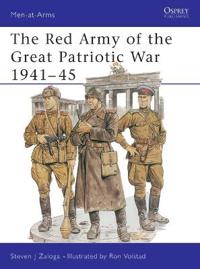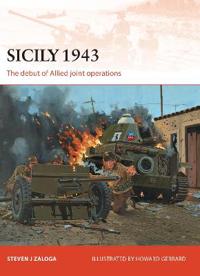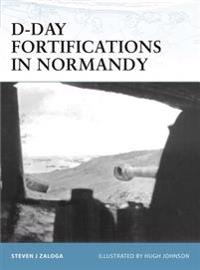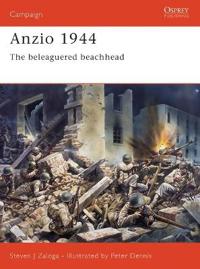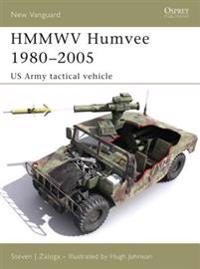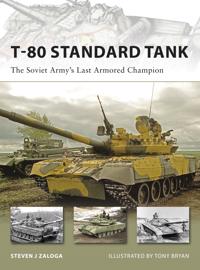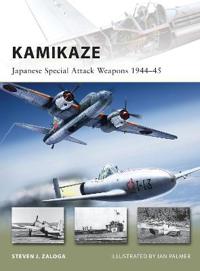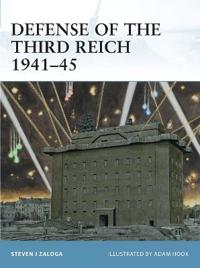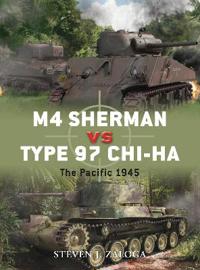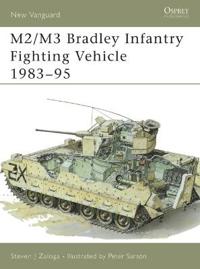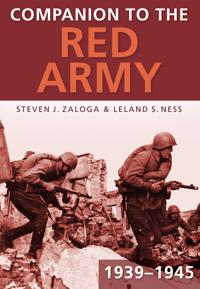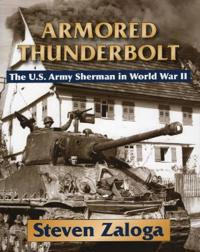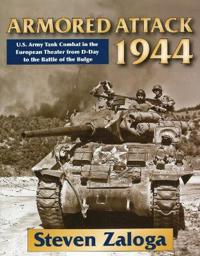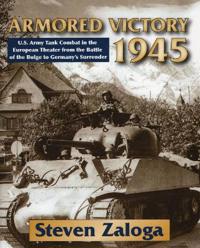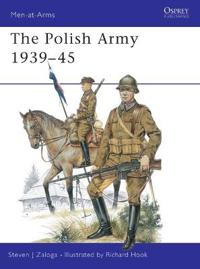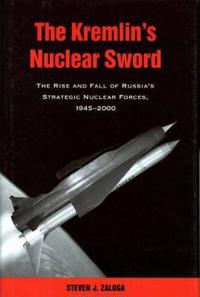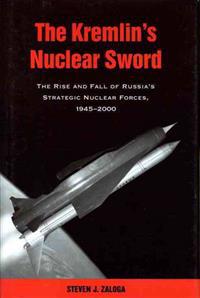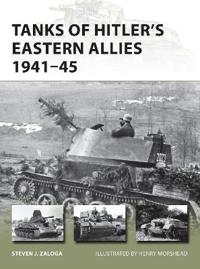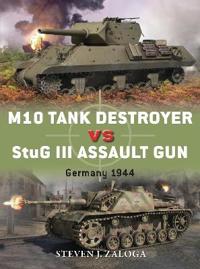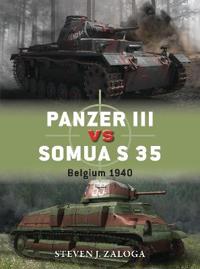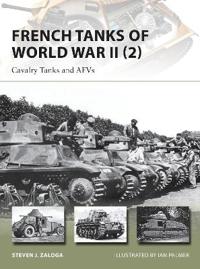Jeeps 1941-45 (Pocket)
avZaloga, Steven J
ISBN: 9781841768885 - UTGIVEN: 2005-11-14The jeep was the most famous military vehicle of World War II, and its name has become synonymous with a whole class of military and civilian all-terrain vehicles. The jeep originated in a prewar US Army requirement for a simple, inexpensive, and robust vehicle for basic utility chores. Its simple d[...]
Red Army of the Great Patriotic War 1941-5 (Pocket)
avSteven J. Zaloga, Ronald (ILT) Volstad, Steven J. Zaloga
ISBN: 9780850459395 - UTGIVEN: 1989-10The German invasion in 1941 led to a series of staggering defeats for the Russians. In the first five months of fighting, the Soviets lost about four million men, amounting to 80 per cent of the total strength of the ground forces at the time of the outbreak of the war. Yet the Red Army managed to h[...]
Panzer IV Vs Sherman (Pocket)
avSteven J. Zaloga, Richard (ILT) Chasemore, Steven J. Zaloga
ISBN: 9781472807601 - UTGIVEN: 2015-08As the Allies attempted to break out of Normandy, it quickly became apparent that there would be no easy victory over the Germans, and that every scrap of territory on the way to Berlin would have to be earned through hard fighting. This study concentrates on the ferocious battles between the German[...]
Sicily 1943 (Pocket)
avSteven J. Zaloga, Howard Gerrard, Steven J. Zaloga
ISBN: 9781780961262 - UTGIVEN: 201301Not only did the Sicily operation represent a watershed in tactical development of combined arms tactics, it was also an important test for future Allied joint operations. Senior British commanders left the North African theater with a jaundiced and dismissive view of the combat capabilities of the [...]
D-Day Fortifications in Normandy (Pocket)
avSteven J. Zaloga, Hugh (ILT) Johnson, Steven J. Zaloga
ISBN: 9781841768762 - UTGIVEN: 2005-11The coastal defenses in Normandy along the D-Day beaches were less thorough than other Atlantic Wall defenses, such as the Pas de Calais, where the Germans expected the main attack. However, they still proved to be formidable obstacles for the Allied invasion force. Rommel stressed the need to defea[...]
Anzio 1944 (Pocket)
avSteven J. Zaloga, Peter (ILT) Dennis, Steven J. Zaloga
ISBN: 9781841769134 - UTGIVEN: 2005-08In January 1944, the Allies made the decision to land at Anzio in order to overcome the stalemate at Cassino. The amphibious landing has become one of the most controversial campaigns of World War II. Three months of World War I-style trench warfare was brought on by a series of missteps from the Al[...]
Hmmwv Humvee 1980-2005 (Pocket)
avSteven J. Zaloga, Hugh (ILT) Johnson, Steven J. Zaloga
ISBN: 9781841769462 - UTGIVEN: 2006-04The HMMWV has set the world standard for army tactical vehicles, since its introduction into the US Army in the 1980s. The Humvee marks another step in the evolution of small tactical vehicles, first started by the legendary Jeep of World War II. Modern armies have a need for a larger vehicle able t[...]
T-80 Standard Tank (Pocket)
avSteven J. Zaloga, Tony (ILT) Bryan, Steven J. Zaloga
ISBN: 9781846032448 - UTGIVEN: 2009-02The Soviet T-80 Standard Tank was the last tank fielded before the Soviet collapse, and the most controversial. Despite having the most sophisticated fire controls and multi-layer armor ever fielded on a Soviet tank, its turbine power plant (rather than a conventional diesel) remained a source of co[...]
The Atlantic Wall (2) (Pocket)
avSteven J. Zaloga, Adam (ILT) Hook, Steven J. Zaloga
ISBN: 9781846033933 - UTGIVEN: 2009-11Germany's Atlantic Wall was the most ambitious military fortification program of World War II. Following its conquest of Western Europe, Germany had to defend some 5,000km of Atlantic coastline from the Spanish border to the Arctic Circle. The United States' entry into the war and the inevitability [...]
Kamikaze (Pocket)
avSteven J. Zaloga, Ian (ILT) Palmer, Steven J. Zaloga
ISBN: 9781849083539 - UTGIVEN: 2011-06"Kamikaze: Japanese Special Attack Weapons, 1944-45".
Eisenhower (Pocket)
avSteven J. Zaloga, Steve (ILT) Noon, Steven J. Zaloga
ISBN: 9781849083591 - UTGIVEN: 2011-08"Eisenhower".
Defense of the Third Reich 1941-45 (Pocket)
avSteven J. Zaloga, Adam Hook, Steven J. Zaloga
ISBN: 9781849085939 - UTGIVEN: 201210Starting in 1940, Germany was subjected to a growing threat of Allied bomber attack. The RAF night bombing offensive built up in a slow but unrelenting crescendo through the Ruhr campaign in the summer of 1944 and culminating in the attacks on Berlin in the autumn and early winter of 1943-44. They w[...]
M4 Sherman Vs Type 97 Chi-Ha (Pocket)
avSteven J. Zaloga, Richard Chasemore, Steven J. Zaloga
ISBN: 9781849086387 - UTGIVEN: 201205Although US and Japanese tank forces first clashed in 1941, it was on in 1944 that tank-vs-tank action became more common as both sides poured larger numbers of tanks into the combat zone. These battles were a means of demonstrating each side's latest tank technology. For the US, the pinnacle of the[...]
M2/M3 Bradley Infantry Fighting Vehicle 1983-95 (Pocket)
avSteven J. Zaloga, Peter (ILT) Sarson, Steven J. Zaloga
ISBN: 9781855325388 - UTGIVEN: 1996-01One of the most sophisticated armoured fighting vehicles in the world, the M2/M3 Bradley is the United States equivalent of the British Warrior, combining the role of personnel carrier with the formidable armament of a 25mm cannon and TOW anti-tank missiles. With a maximum road speed of 66kmh it als[...]
Companion to the Red Army 1939-45 (Häftad)
avSteven J. Zaloga, Leland S. Ness
ISBN: 9780752454757 - UTGIVEN: 200911Stalin's Red Army entered the Second World War as a relatively untried fighting force. In 1941, with the launch of Operation 'Barbarossa', it joined the battle with Hitler's army, the most powerful in history. After a desperate war of attrition over four years, the Red Army defeated the Nazis on the[...]
Armored Thunderbolt (Inbunden)
avSteven J. Zaloga
ISBN: 9780811704243 - UTGIVEN: 200811This book features hundreds of photos, including many never published before. It provides riveting accounts of armoured warfare in World War II. It compares the Sherman to other tanks, including the Panther and Tiger. The author is a world-renowned expert on the Sherman tank and American armour. Som[...]
Armored Attack 1944 (Inbunden)
avSteven J. Zaloga
ISBN: 9780811707695 - UTGIVEN: 201110* An exploration of the U.S. Army Tank combat that played a vital role in the wining of World War II The tank played a key role in many of the battles of World War II; it was an indispensable weapon that could halt entire armies and wreak havoc on the battlefield. Early in the war it was the German[...]
Armored Victory 1945 (Inbunden)
avSteven J. Zaloga
ISBN: 9780811707718 - UTGIVEN: 201202Superb volume covering numerous American tanks and armoured vehicles Stackpole present this beautifully illustrated volume of more than 1,000 photos of American tanks and armoured vehicles. From Shermans to Hellcats all varieties of American armour are covered in extensive detail. This volume compl[...]
The Polish Army, 1939-45 (Inbunden)
avSteven J. Zaloga
ISBN: 9780850454178 - UTGIVEN: 1982-01Poland was the first of the Allied nations to succumb to German aggression in the Second World War, but by the most tortuous of routes her army managed to remain in the field through all five years of bloody fighting. Polish soldiers fought in nearly every major campaign in the European theatre, and[...]
The Kremlin's Nuclear Sword (Inbunden)
avSteven J. Zaloga
ISBN: 9781588340078 - UTGIVEN: 200202The Kremlin's Nuclear Sword examines how the Soviet aerospace industry shaped many of the key defense decisions during the Cold War. Drawing from elusive Russian source material and interviews with many Russian and Ukrainian engineers, Steven J. Zaloga presents a definitive account of Russia's strat[...]
The Kremlin's Nuclear Sword (Häftad)
avSteven J. Zaloga
ISBN: 9781588344847 - UTGIVEN: 2014-05The prevailing Western view of Russia's Cold War strategic nuclear weapons policy is that it resulted from a two-part interplay between the leaders of the Communist Party and the military. Steven J. Zaloga has found that a third contributor--the Russian defense industry--also played a vital role.
Tanks of Hitler's Eastern Allies, 1941-45 (Häftad)
avSteven J. Zaloga
ISBN: 9781780960203 - UTGIVEN: 201304The titanic armor battles of the Russian Front are widely known, but the role of Germany's eastern allies is not as well known. Two of these countries, Romania and Hungary, manufactured their own tanks as well as purchasing tanks from Germany. These ranged from older, obsolete types such as the PzKp[...]
M10 Tank Destroyer Vs Stug III Assault Gun (Häftad)
avSteven J. Zaloga
ISBN: 9781780960999 - UTGIVEN: 201308The Allies' M10 Tank Destroyer and the Germans' Sturmgeschutz (StuG) lll were the unsung workhorses of the northwest European battlefields of 1944-45. While their mission was not principally fighting one another, their widespread use ensured their frequent encounters, from the Normandy Bocage, to th[...]
Panzer III vs Somua S 35 (Häftad)
avSteven J. Zaloga
ISBN: 9781782002871 - UTGIVEN: 2014-11The armour clashes in May 1940 were the biggest the world had yet seen, as the sweeping German advances of that period came to epitomize Blitzkrieg. The Wehrmacht's Panzer III was well matched by the French Somua S35 tanks, the two representing very different design philosophies and yet both ranking[...]
French Tanks of World War II (Häftad)
avSteven J. Zaloga
ISBN: 9781782003922 - UTGIVEN: 2014-07The sequel to French Tanks of World War II (1), this title focuses primarily on France's cavalry armored vehicles, including the light reconnaissance tanks such as the AMR and AMC families, the famous Somua S.35 cavalry tanks and the extensive array of armored half-track and armored cars used by the[...]


